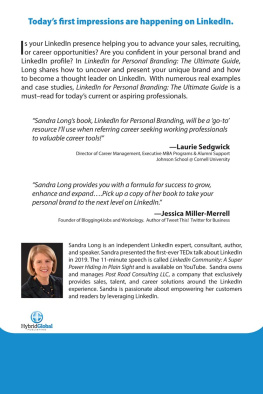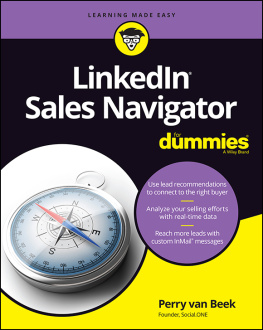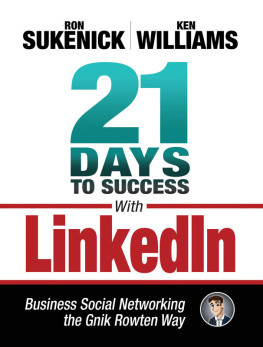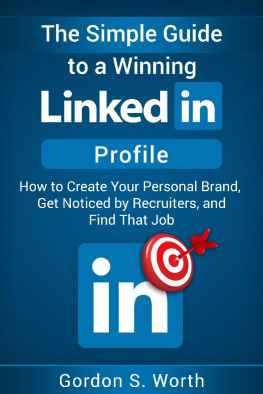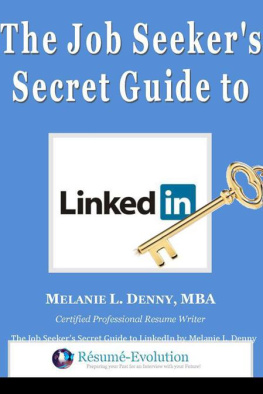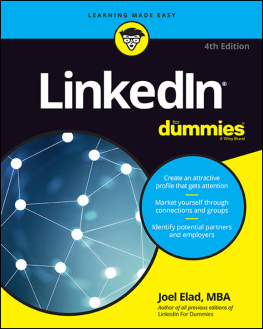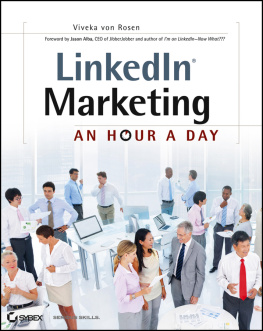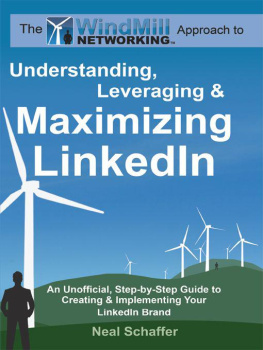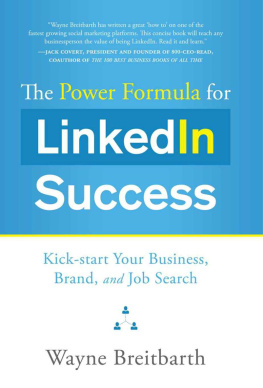Michael Winicott
LINKEDIN:
JOB SEARCH AND CAREER BUILDING
How to Use LinkedIn for Employment andCareer Branding
ALL RIGHTS RESERVED. No part of this publication may be reproduced or transmitted in any form whatsoever, electronic, or mechanical, including photocopying, recording, or by any informational storage or retrieval system without express written, dated and signed permission from the author.
2015 by Michael Winicott.
2015 by UNITEXTO
Published by UNITEXTO
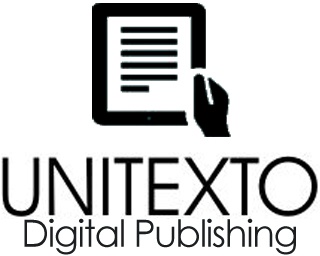
Table of Contents
Conclusion
When it comes to social networking, chances are that you may be using at least one or two or more social networking sites to keep yourself informed on your friends activities and to check whats new on networks you follow. If you are presently employed and not using LinkedIn as a tool to connect and stay updated with people, companies and groups in your industry, you are committing a serious mistake. Its time to reconsider your view of professional networking.
Being the worlds largest networking site for professionals, LinkedIn is an innovative way to connect with people in almost any industry. It is the most powerful tool of modern age to create and manage your professional identity and brand your career. It gives you opportunities to connect and engage with professionals, and access knowledge, insights and opportunities. LinkedIn keeps you informed about your contact and industry and helps you find the people and knowledge you need to achieve your professional goals.
There is a serious misconception that LinkedIn is only for people seeking job. With almost 347 million LinkedIn users worldwide, we can honestly say the not even 50 percent of them are vigorously looking out for employment. A majority of these users are employed and networking to stay on top of their career.
According to a study conducted by Jobvite in 2014, there were 94 percent of active recruiters on LinkedIn, and only 36 percent of job seekers. Moreover, a majority of the recruiters said they do most of the hiring through LinkedIn. These facts reinforce the theory that the traditional ways of recruitment are fading and employers are increasingly using innovative ways like LinkedIn to find and recruit talent.
Not only is LinkedIn a tool for effective recruitment for employers, it is also a tool for job seekers to find their dream job. However, this does not mean that the function of LinkedIn is limited to job search and recruitment. It is a complete career branding kit. Read on to know how.
Creating a profile on LinkedIn now, actively participating and building a strong network can not only be enjoyable, but can also help you in furthering your professional goals at some point in your career. Imagine for a moment that you got fired from your current job; suddenly you realize the importance of LinkedIn. So you create a profile on LinkedIn in a hurry and start adding people to your network like wild.
If LinkedIn doesnt catch you for doubtful behavior, then the hordes of new people you are trying to add to your network may question your purpose. They might ask, Well, I have not heard from this person in almost a decade, and now suddenly he has been laid off and wants to connect. What is his intention?
This reinforces the importance of creating a large network on LinkedIn and staying connected even if you are happily employed. Dont wait to join the network until you are in need. Participate actively. Show your connections that you really know how to do things in your industry. Keep in touch.
A majority of employers on LinkedIn try to recruit people who are already employed or people who are not actively looking for job. This is understandable, given that there are enough jobless people in the country, and on LinkedIn. What they want is someone who can provide value, has the skills, and is not actively looking for employment.
Your profile on LinkedIn is something recruiters would check to see if you have the necessary skills, experience and knowledge for the vacant position.
In other words, recruiting companies try to pilfer and snatch valuable professionals from their competitors. When they approach you, they are obviously eager to offer your more in terms of money and professional growth. By not being on LinkedIn, you are missing the chance to be discovered by better companies that offer more growth and development opportunities, and of course more money.
Joining your industry groups on LinkedIn can give you access to connections and opportunities. You can find engaging discussions over topics of your interest and can speak your mind. If you provide value to the group and demonstrate your knowledge and skills, you will find more connections and opportunities will come to you.
As recruitment is gradually taking innovative turns and steadily more employers are shifting to LinkedIn to find talent, keeping your profile updated will let potential employers to find and contact you. Remember, resume is a static, old thing now. You use it only when you are actively looking for an employment.
On the contrary, you keep your LinkedIn profile updated no matter if you are looking for opportunities or not. Employers are well aware that your LinkedIn profile is more accurate than your resume. You never know when your current employer would stop loving you, so keep your LinkedIn profile updated. It will also help you in updating your resume.
LinkedIn can keep you on top of updates and news in your industry. The network offers you the opportunity to regularly get customized news feeds, articles and updates about your industry. Armed with the updated information, you can leap far ahead of other competing candidates in any potential job interview. In other words, LinkedIn builds your talent, so you can grow and develop professionally.
LinkedIn is a very useful and powerful network for every employed individual; let alone every job seeker and student. However, the bad news is that not every casual LinkedIn user is aware of its power as a job-search tool.
If you are updating your LinkedIn profile from time to time and then waiting for potential employers to recruit you, you are missing the opportunity. This tool has a huge database containing millions of records crucial to the job-hunting strategy of every user.
For example, a big company opened up its office in your area and you are curious if they need someone with skills and experience like you. The traditional ways of calling or writing to the companys HR department are no more workable.
There is this powerful tool called LinkedIn that would help ease your tedious task. Just log in to your LinkedIn network, go to the companys profile and there you see some of your friends and connections already working in your target company. Now you can reach out to your connections working there to get all information on any openings. Smart job, but this is not all.
Now you go to the LinkedIn profiles of the companys top management and there you find that one of them went to your graduate alma mater. Here is the good news: your Alumni Office can help you get it touch with him or her if you think personally approaching him would not be the right way. You also find that one of the companys executives is a board member of a non-profit organization where your friends mom is an executive. Now you can use this connection to your advantage as well.
Your LinkedIn profile is a tool to broadcast your strengths, skills, achievements, competencies, talent and future aspirations. Additionally, it is a tool to make first impression to anyone who finds you on the network, be it a past or future colleague intending to connect with you, a prospective client, or a potential employer. Understanding the importance of a killer profile is good, but more important is to know where to begin and what information to put up. It can be somehow daunting at the outset.
Next page

